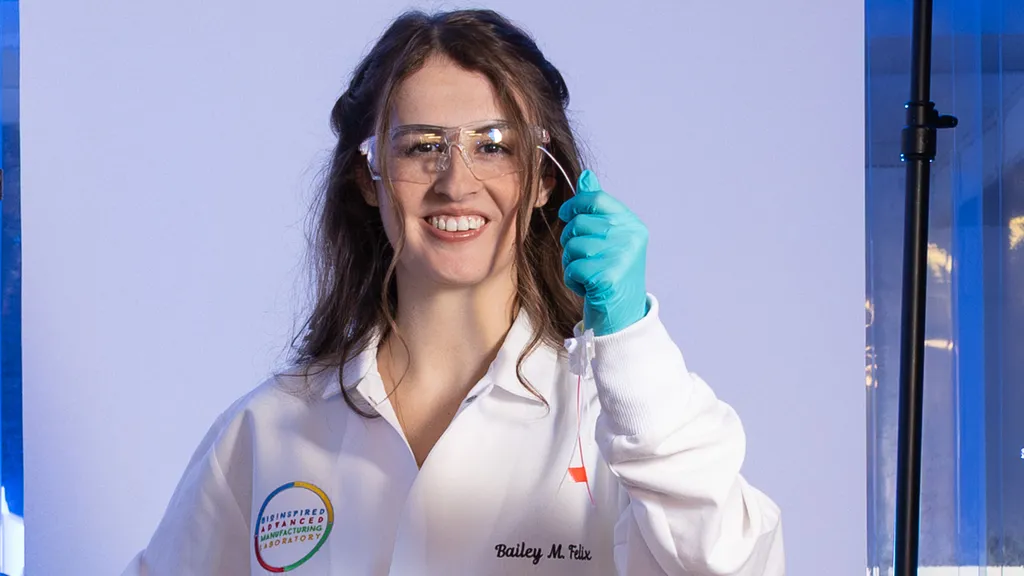- October 22, 2025
- By Jennifer S. Holland M.S. ’98
When most of us hit “print,” we get a copy of an overdue English paper or a parking pass for the ball game. But when University of Maryland engineers in the Bioinspired Advanced Manufacturing (BAM) Laboratory instruct the latest 3D nanoprinter to do its thing, the outcome is a revolutionary, and tiny, piece of “soft robotics” hardware that could vastly improve the effectiveness of chemotherapy and other life-saving medical treatments.
Bioengineering Ph.D. student Bailey Felix and colleagues are 3D printing polymer robotic microcatheters the thickness of a grain of sand that can be actively steered to navigate through blood vessels. Their size, shape and controllability could make them a powerful surgical tool for shuttling medicine to liver tumors—a strategy known as “transarterial” cancer treatment.

“Chemotherapy is designed to kill, and it doesn’t care if cells are healthy or not,” said Felix, a Clark Doctoral Fellow and U.S. National Science Foundation (NSF) Graduate Research Fellow working under Associate Professor Ryan Sochol, interim director of the Maryland Robotics Center. The two are collaborating with clinicians and researchers from the University of Maryland School of Medicine and Johns Hopkins University.
Global deaths from liver cancer are expected to increase by more than 55% by 2040, according to recent research. In the U.S. alone, cases have tripled, and deaths have doubled since 1980.
The scattershot nature of chemo means patients can suffer horrific side effects but may not get the full benefit of the medication. “We wanted to deliver chemo in a more targeted way, by driving through blood vessels that go directly to the tumor,” Felix said.
While there are catheters and guidewires on the market now with similar aims, “they’re really hard to use and aren’t easily steered,” she said. “All you can do is push, pull and twist, potentially causing more problems than you fix.”
In addition, today’s guidewires, which are typically bent by hand, are metal, so they can’t be employed while a patient is undergoing magnetic resonance imaging (MRI), and the body’s natural warmth can make them lose their shape.
Working with surgeons and experts in medical robotics and machine learning, the team designed its robotic microcatheter to be steered using fluids. That means the user manipulates tiny amounts of saline to inflate the chamber and to bend and push the flexible tube through the narrowest of spaces. The new tool, a soft robot (made of flexible instead of hard materials), is minimally invasive, inserted through a tiny incision in the groin or wrist to snake its way toward a tumor and precisely deliver drugs. “We’re not inventing a new treatment option,” said Felix. “We’re creating a better way to get an existing treatment where it needs to go.”
Advances in 3D printing have helped make this technology possible. “Our newest 3D nanoprinter lets us create shapes and geometries previously impossible to construct,” Sochol said. “Even just five years ago, there would not have been a way to build this sophisticated microcatheter.”
Considering other medical challenges the robot might address, the UMD team consulted surgeons including Dr. Dheeraj Gandhi, a neurologist at the University of Maryland School of Medicine at the University of Maryland, Baltimore, who focuses on neuro-interventional surgeries. “The brain’s vasculature is deeply complex, in part because of its frequent branching, “and threading a conventional wire-led catheter through tight turns in the network requires a lot of guesswork.” The softness of the ‘bot and its controllable tip, he said, would let him “enter the neck of an aneurism no matter how oddly shaped, without risking rupture or going too deep.”
As the team prepares to begin animal testing soon, Felix said she hopes their microcatheter will provide a new treatment measure for liver tumors, for starters. Beyond tumors, the next generation of ultra-targeted drug-delivery products has potential to serve a host of other medical needs, including, for a surgeon like Dr. Gandhi, guiding tiny platinum coils to brain aneurisms to promote clotting and treating arteriovenous malformations.
“The future of medicine is increasingly robotic and automated,” Sochol said, “unlocking faster, safer treatment options that can dramatically improve lifesaving care.”
(Photo by John T. Consoli)
UMD Research Changes Lives
At the University of Maryland, scientists and scholars come together to spark new ideas, pursue important discoveries and tackle humanity's grand challenges—improving lives in our communities and across the globe. See more examples of how UMD research changes lives at today.umd.edu/topic/research-impact.
